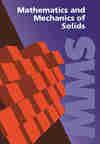Does the capacitor analogy model in fracture mechanics of elastic dielectrics constitute an appropriate approximation?
IF 1.7
4区 工程技术
Q3 MATERIALS SCIENCE, MULTIDISCIPLINARY
引用次数: 0
Abstract
The analytical solution of an elliptic dielectric cavity in an infinite dielectric plate is taken as basis to investigate a Griffith crack problem which is obtained by letting the semi-minor axis tend towards zero. In the course of this, an erroneous conformal mapping, commonly employed in literature and correctly reproducing the electric field only in a part of the physical space, is rectified. Interpreting the elliptic interface as faces of a mechanically opened crack which is exposed to an oblique remote electric field, surface charges and electrostatic tractions are calculated. In contrast to the established capacitor analogy model, approximately yielding electric charge densities and Coulombic tractions from displacements and electric potentials in the undeformed crack configuration, the work at hand provides exact solutions accounting for different implications of the crack curvature and for the inclination of the electric field. Crack weight functions are finally used to calculate stress and electric displacement intensity factors. As turns out, the surface charges of the capacitor analogy represent an excellent substitute for the exact electric boundary conditions within a relevant range of parameters, whereas inaccurate Coulombic tractions in the vicinity of crack tips may lead to a significantly overestimated mode I stress intensity factor.弹性电介质断裂力学中的电容器类比模型是否构成适当的近似值?
以无限介质板中椭圆介质腔的解析解为基础,研究了通过让半小轴趋向于零而得到的格里菲斯裂缝问题。在此过程中,纠正了文献中常用的错误保角映射,这种映射只在物理空间的一部分正确再现电场。将椭圆形界面解释为暴露在斜向远程电场中的机械开裂面,计算出表面电荷和静电牵引力。与已建立的电容器类比模型(根据未变形裂缝配置中的位移和电动势近似得出电荷密度和库仑牵引力)相比,目前的研究提供了精确的解决方案,考虑到了裂缝曲率和电场倾斜度的不同影响。裂纹权重函数最终用于计算应力和电位移强度因子。结果表明,在相关参数范围内,电容器类比的表面电荷可以很好地替代精确的电边界条件,而裂纹尖端附近不准确的库仑牵引力可能会导致模式 I 应力强度因子被大大高估。
本文章由计算机程序翻译,如有差异,请以英文原文为准。
求助全文
约1分钟内获得全文
求助全文
来源期刊

Mathematics and Mechanics of Solids
工程技术-材料科学:综合
CiteScore
4.80
自引率
19.20%
发文量
159
审稿时长
1 months
期刊介绍:
Mathematics and Mechanics of Solids is an international peer-reviewed journal that publishes the highest quality original innovative research in solid mechanics and materials science.
The central aim of MMS is to publish original, well-written and self-contained research that elucidates the mechanical behaviour of solids with particular emphasis on mathematical principles. This journal is a member of the Committee on Publication Ethics (COPE).
 求助内容:
求助内容: 应助结果提醒方式:
应助结果提醒方式:


